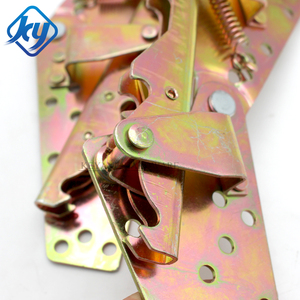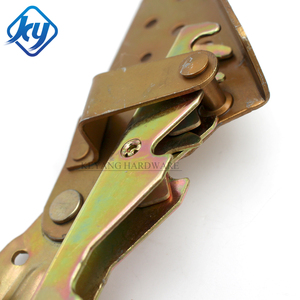(218032 products available)










































































































































A door closer is a mechanical device that automatically closes a door after it has been opened. It helps to ensure that doors are closed for security and safety purposes. Door closers are commonly found in commercial buildings, offices, hotels, parking lots, and residential homes.
Door closers work by using different mechanisms to control the speed and force with which a door closes. They are installed at the top of the door and frame, as well as the bottom of the door in some cases. There are different types of door closer mechanisms, including:
Hydraulic door closer
A hydraulic door closer is one of the most popular types. It uses hydraulic fluid and pistons to control the closing of the door. When the door is pushed open, hydraulic fluid moves through a cylinder, controlling the speed and movement of the door. This mechanism allows for a smooth and quiet closing. Hydraulic door closers are commonly used in commercial and residential doors.
Spring door closer
Spring door closers use a spring mechanism to close the door. They are usually installed on lighter doors and are more affordable than hydraulic closers. When the door is opened, a coiled spring inside the closer is compressed. Once the door is released, the spring will slowly and steadily pull the door back to the frame.
Electromagnetic door closer
Electromagnetic door closers are advanced and are typically used in fire control doors or areas that require electronic access control. They use an electromagnet to hold the door open when needed. Once the power is cut off, a spring will pull the door closed. They are very effective for high-traffic areas.
Ball bearing door closer
This type of closer uses ball bearings to reduce friction between moving parts. The bearings are placed in a track, and as the spring is compressed, the balls will roll along the raceways. This mechanism can be used for heavy or light doors. They provide a faster closing speed and are more durable.
Cam and Roller door closer
These door closers use a cam and roller mechanism. The cam converts linear motion from a spring into rotational motion. It moves smoothly over a series of rollers that reduce friction. The cam and roller door closer is best suited for light internal doors. They are less powerful than hydraulic and spring door closers.
Concealed door closer
Concealed door closers are installed inside the frame and door, so they are not visible. They use hydraulic or mechanical systems to close the door. These types of door closers are more aesthetically pleasing because they are hidden. However, installation and maintenance are more complex.
There are different types of lifting mechanisms for beds, and each has unique features and functions. Here are some common features and functions of bed lift mechanisms:
Hydraulic System
The hydraulic system usually consists of two pistons connected to the bed frame and the mattress. The system can easily raise and lower the mattress with minimal effort. This system is commonly found in ottoman beds. It provides smooth and quiet operations and enhances stability and safety when lifting the bed.
Gas Lift Mechanism
This mechanism uses gas springs to lift and lower the mattress. It usually consists of two or more gas struts attached to the bed frame and the underside of the mattress. This mechanism provides easy lifting with minimal effort. For example, a queen or king-sized bed can easily be lifted with only one hand. It also enhances safety and stability when lifting the bed. The gas lift mechanism is commonly found in ottoman beds and provides smooth and silent operations.
Pneumatic Lift
The pneumatic lift mechanism uses air pressure to raise and lower the mattress. It consists of a compressor, air cylinders, and control switches. The compressor creates and delivers air to the cylinders, which in turn lift and lower the mattress. This mechanism offers easy lifting with minimal effort.
Mechanical Bed Lift
The mechanical bed lift uses a crank and pole mechanism to lift and lower the mattress. It requires more effort to lift the mattress but is more durable and reliable. It can be used in lifting heavier mattresses.
Smart Lift Mechanism
This mechanism is advanced as it uses electronic motors and control systems to lift and lower the mattress. It usually has remote controls, touch panels, and sensors that can automatically adjust the bed height and position. This mechanism provides effortless lifting and lowering and offers a range of positions for storage access and customized comfort.
There are several scenarios where a door closer mechanism is used. These are discussed in detail below:
Commercial Buildings
Office Spaces: Automatic door closers are commonly found in commercial office buildings. They ensure that doors close automatically after being opened. This feature provides convenience and prevents doors from being left ajar, which promotes security and privacy.
Retail Stores: Door closers are also installed in retail store entrance doors. They allow customers to enter and exit the store easily while ensuring the doors close securely behind them. This helps maintain an inviting storefront and enhances security by deterring unauthorized access.
Educational Institutions
Schools and Universities: Door closers are used in classroom doors, dormitory entrances, and administrative offices. They enable smooth traffic flow between rooms while ensuring doors close quietly and securely. This helps maintain a focused learning environment and enhances security by preventing unauthorized access to restricted areas.
Healthcare Facilities
Hospitals and Clinics: Automatic door closers are crucial in healthcare settings. They allow for the swift and secure closing of doors in patient rooms, operating theaters, and storage areas. This feature is particularly important in emergency situations, where doors need to close quickly to maintain privacy or quarantine areas.
Residential Homes
Single-Family Homes: Door closers are installed in exterior doors, such as entry doors and garage-to-home doors. They ensure doors close securely, preventing unauthorized entry and maintaining energy efficiency by keeping conditioned air inside.
Apartment Buildings: In multi-unit residences, door closers are commonly used in common area doors, such as those leading to hallways, fitness centers, and laundry rooms. They provide convenience for residents and ensure the closure of doors to maintain privacy and security between units.
Public Buildings
Government Offices: Door closers are commonly used in government buildings to ensure doors close securely and quietly in areas such as reception areas, meeting rooms, and office spaces. This helps to maintain a professional atmosphere and privacy in sensitive discussions.
Libraries: In libraries, door closers are installed to ensure doors close silently and smoothly, allowing for a peaceful and uninterrupted reading experience for patrons.
Before purchasing any product, it is essential to consider the important factors to ensure customers get exactly what they want. Below are some of the factors business owners should consider when choosing or purchasing an order.
Safety features
Safety should be the most important consideration when choosing an or mechanism. Look for or mechanisms with safety features like safety stops, safety sensors, and emergency brakes. These features help prevent accidents and injuries.
Load capacity and size
Consider the size of the load and the capacity of the or mechanism. Different or mechanisms have different load capacities. Choose an or mechanism with a load capacity that is enough for your needs. Also, consider the dimensions of the or mechanism to ensure it is compatible with the space available.
Power source
Or mechanisms can be powered by batteries, solar energy or electricity. Consider the availability of these power sources in the area to determine the best or mechanism. Electric or mechanisms are more efficient, while battery-powered or mechanisms offer more flexibility.
Quality and reliability
The quality of the or mechanism plays a major role in its performance. Choose or mechanisms from reputable manufacturers to ensure reliability and durability. Read reviews and testimonials to learn the experiences of other customers.
Ease of installation and maintenance
Another important thing to consider when choosing or mechanisms is the ease of installation and maintenance. Some or mechanisms are more complicated than others. Choose or mechanisms that are simple to install and maintain to save time and reduce costs.
Cost
While it's important to choose an or mechanism that meets all the requirements, it's also important to consider its cost. Compare the prices of different or mechanisms and choose the one that fits your budget. However, don't compromise safety or quality for a lower price.
Q1: What are the advantages of a sliding door over a hinge door?
A1: Sliding doors are more space-efficient because they do not require clearance to swing open. They can also provide a larger opening than a hinged door and allow more natural light, making the room look more spacious.
Q2: What is the main disadvantage of a sliding door?
A2: The main disadvantage is that sliding doors cannot be fully opened to one side, limiting the size of the opening compared to hinged doors. Also, the tracks can be a tripping hazard and may require frequent cleaning to operate smoothly.
Q3: What are the three main types of sliding doors?
A3: The three main types are parallel sliding doors, lift-and-slide doors, and folding sliding doors. The lift-and-slide kind can be tilted up to seal better and then lowered to slide open easily. Folding doors stack and fold to one side.
Q4: What is a sliding door lock called?
A4: A sliding glass patio door lock is called a hook bolt lock. It has a hook-shaped bolt that extends into a metal plate when the door is locked. The hook bolt makes it harder to pry open the door from the outside.
Q5: What are the disadvantages of sliding windows?
A5: They can only be opened halfway for ventilation and may leak air if not installed properly. The tracks must be kept clean for the windows to slide smoothly, and the screen mesh may need to be replaced over time.